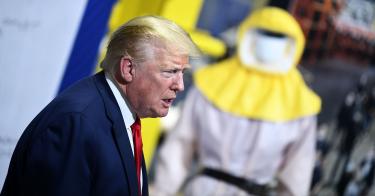The U.S. unemployment rate is now more than 14%. Monthly retail sales are down double digits. Manufacturing demand has been weakening since the beginning of the year.
Times are tough.
Washington is trying to prop up the economy with round after round of stimulus packages, personal checks for Americans, and relaxing regulations that inhibit economic growth.
At the same time, the Trump administration is working closely with private companies to make sure Americans can get critical equipment and that essential businesses can stay open.
All levels of federal and state government are working hard to make sure the cost of containing the COVID-19 pandemic is not worse than the disease itself. Yet, there are still great concerns about future economic recovery. How long will it take? What are the long-term implications? And, most importantly, when does it begin?
In the first three months of 2020, the U.S. economy contracted by 4.8% and some analysts suggest the worst has yet to come.
In those same three months, the Treasury collected $18 billion in customs duties—the tax paid by Americans for imports.
If the worst has yet to come and the government is looking for ways to ease the pain for American businesses and families, one obvious step would be to stop collecting these tariffs.
In late April, the administration did implement a partial, 90-day freeze for certain payments on imports. But few companies were able to take advantage of this freeze, and significant tariffs remained on hundreds of billions worth of imports of steel, aluminum, washing machines, and imports from the European Union and China.
With so many American families struggling financially, are these tariffs worth keeping? The revenues generated are barely a drop in the Treasury’s bucket, but the money that goes for tariffs could make a big difference to families and small businesses trying to bounce back from the economic hardship occasioned by the lockdown.
But your average American doesn’t have the weight of the federal government. Tariffs on imports from China are estimated to cost the typical family as much as $767. That’s a lot, considering that most Americans do not have even $500 in savings.
It’s also a lot compared to recent history. The average tariff rate on all U.S. imports has doubled over the last two years because of U.S. trade policy decisions.
The White House argues that the remaining tariffs (particularly those on European and Chinese imports) need to stay in place to give the U.S. leverage in negotiating a better trade deal with Beijing. It’s an odd argument, however, now that the U.S. and China already have a deal on the table.
We can debate whether China will be able to meet the part of the agreement that says they’ll buy $200 billion more in American goods these next two years. (Spoiler: They won’t). Or whether there will be a second U.S.-China deal. (Don’t hold your breath waiting for this one.) But other aspects of the deal have already been implemented, much to the delight of U.S. officials. And yet, tariffs remain.
Meanwhile, certain tariffs on imports from Europe have actually cast a shadow over U.S.-European relations. If the U.S. is looking for friends to pressure against China’s illiberal economic practices, they’ll be harder to find in Europe as long as those tariffs remain.
But those are the long-term implications. In the short term, as millions more people file for unemployment insurance every week, tariffs continue to dampen consumer demand and business hiring.
Businesses shouldn’t need to worry about the added cost of tariffs or the uncertainty recent trade policy has brought to their supply chains right now.
If the Trump administration and Congress would get rid of the tariffs on imports, it would free up to $6 billion a month for Americans.
This piece originally appeared in The Washington Times



